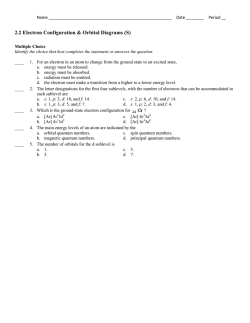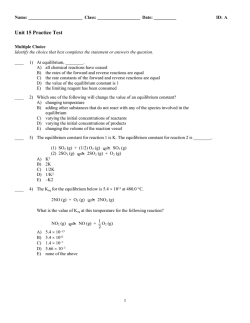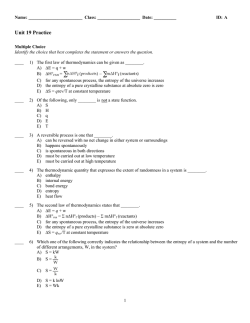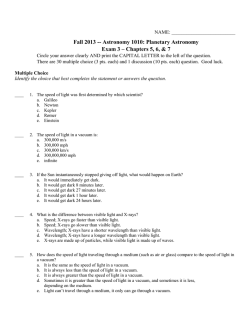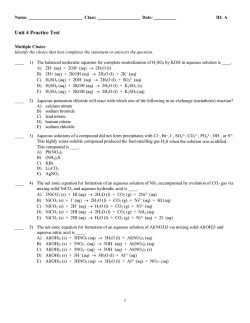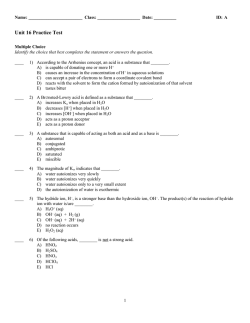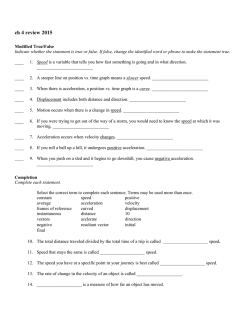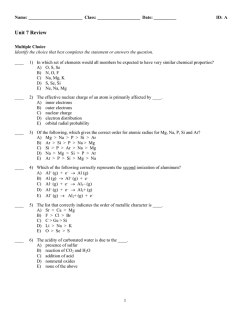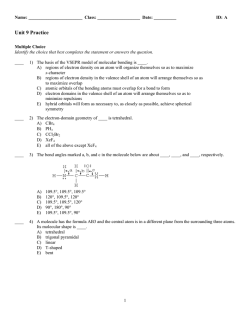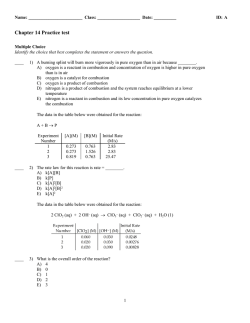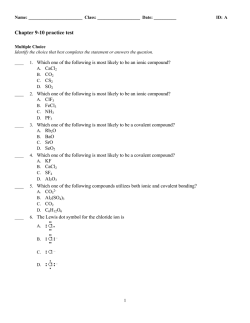
Unit 13 Practice Test
Name: ________________________ Class: ___________________ Date: __________ ID: A Unit 13 Practice Test Multiple Choice Identify the choice that best completes the statement or answers the question. ____ 1) The dissolution of water in octane (C 8H18) is prevented by ________. A) London dispersion forces between octane molecules B) hydrogen bonding between water molecules C) dipole-dipole attraction between octane molecules D) ion-dipole attraction between water and octane molecules E) repulsion between like-charged water and octane molecules ____ 2) Hydration is a specific example of the phenomenon known generally as ________. A) salutation B) disordering C) solvation D) condensation E) dilution ____ 3) Compounds composed of a salt and water combined in definite proportions are known as ________. A) clathrates B) homogenates C) ionic solids D) molecular solids E) hydrates ____ 4) The principal reason for the extremely low solubility of NaCl in benzene (C 6H6) is the ________. A) strong solvent-solvent interactions B) hydrogen bonding in C 6H6 C) strength of the covalent bond in NaCl D) weak solvation of Na+ and Cl– by C6H6 E) increased disorder due to mixing of solute and solvent ____ 5) Which of the following substances is more likely to dissolve in CH 3OH? A) CCl4 B) Kr C) N2 D) CH3CH2OH E) H2 ____ 6) Which one of the following substances is more likely to dissolve in benzene (C 6H6)? A) CH3CH2OH B) NH3 C) NaCl D) CCl4 E) HBr 1 Name: ________________________ ID: A ____ 7) The solubility of nitrogen gas at 25 °C and 1 atm is 6.8 10–4 mol/L. If the partial pressure of nitrogen gas in air is 0.76 atm, what is the concentration (molarity) of dissolved nitrogen? A) 6.8 10–4 M B) 5.2 10–4 M C) 4.9 10–4 M D) 3.8 10–4 M E) 1.1 10–5 M ____ 8) Which of the following statements is false? A) Nonpolar liquids tend to be insoluble in polar liquids. B) The weaker the attraction between the solute and solvent molecules, the greater the solubility. C) Substances with similar intermolecular attractive forces tend to be soluble in one another. D) The solubility of a gas increases in direct proportion to its partial pressure above the solution. E) The solubility of gases in water decreases with increasing temperature. ____ 9) Calculate the molarity of a 10.0% (by mass) aqueous solution of hydrochloric acid. A) 0.274 m B) 2.74 m C) 3.04 m D) 4.33 m E) The density of the solution is needed to solve the problem. ____ 10) Which one of the following concentration units varies with temperature? A) molarity B) mass percent C) mole fraction D) molality E) all of the above ____ 11) A 0.100 m solution of which one of the following solutes will have the lowest vapor pressure? A) KClO4 B) Ca(ClO4)2 C) Al(ClO4)3 D) sucrose E) NaCl ____ 12) Which of the following liquids will have the lowest freezing point? A) pure H2O B) aqueous glucose (0.60 m) C) aqueous sucrose (0.60 m) D) aqueous FeI3 (0.24 m) E) aqueous KF (0.50 m) 2 Name: ________________________ ID: A ____ 13) A 1.35 m aqueous solution of compound X had a boiling point of 101.4 °C. Which one of the following could be compound X? The boiling point elevation constant for water is 0.52 °C/m. A) CH3CH2OH B) C6H12O6 C) Na3PO4 D) KCl E) CaCl2 ____ 14) The most likely van't Hoff factor for an 0.01 m CaI 2 solution is ________. A) 1.00 B) 3.00 C) 1.27 D) 2.69 E) 3.29 ____ 15) Calculate the vapor pressure of a solution made by dissolving 109 grams of glucose (molar mass = 180.2 g/mol) in 920.0 ml of water at 25 °C. The vapor pressure of pure water at 25 °C is 23.76 mm Hg. Assume the density of the solution is 1.00 g/ml. A) 0.278 mm Hg B) 0.605 mm Hg C) 22.98 mm Hg D) 23.48 mm Hg E) 23.76 mm Hg ____ 16) Which of the following cannot be a colloid? A) an emulsion B) an aerosol C) a homogeneous mixture D) a foam E) All of the above are colloids. ____ 17) The solubility of Ar in water at 25 °C is 1.6 10–3 M when the pressure of the Ar above the solution is 1.0 atm. The solubility of Ar at a pressure of 2.5 atm is ________ M. A) 1.6 103 B) 6.4 10–4 C) 4.0 10–3 D) 7.5 10–2 E) 1.6 10–3 ____ 18) The solubility of MnSO 4 monohydrate in water at 20 °C is 70.0 g per 100.0 mL of water. A solution at 20 °C that is 4.22 M in MnSO 4 monohydrate is best described as a(n) ________ solution. The formula weight of MnSO4 monohydrate is 168.97 g/mol. A) hydrated B) solvated C) saturated D) unsaturated E) supersaturated 3 Name: ________________________ ID: A ____ 19) A solution is prepared by dissolving 23.7 g of CaCl 2 in 375 g of water. The density of the resulting solution is 1.05 g/mL. The concentration of Cl – in this solution is ________ M. A) 0.214 B) 0.562 C) 1.12 D) 1.20 E) 6.64 10–2 ____ 20) The concentration of HCl in a solution that is prepared by dissolving 5.5 g of HCl in 200 g of C 2H6O is ________ molal. A) 27.5 B) 7.5 10–4 C) 3.3 10–2 D) 0.75 E) 1.3 ____ 21) The concentration of urea (MW = 60.0 g/mol) in a solution prepared by dissolving 16 g of urea in 39 g of H 2O is ________ molal. A) 96 B) 6.8 C) 0.68 D) 6.3 E) 0.11 ____ 22) What is the mole fraction of sodium chloride in solution that is 13.0% by mass sodium chloride and that has a density of 1.10 g/mL? A) 0.0442 B) 0.0462 C) 0.223 D) 0.483 E) 0.505 ____ 23) A solution containing 10.0 g of an unknown liquid and 90.0 g water has a freezing point of –3.33 °C. Given K f = 1.86 °C/m for water, the molar mass of the unknown liquid is ________ g/mol. A) 69.0 B) 333 C) 619 D) 161 E) 62.1 ____ 24) An aqueous solution of a soluble compound (a nonelectrolyte) is prepared by dissolving 33.2 g of the compound in sufficient water to form 250 mL of solution. The solution has an osmotic pressure of 1.2 atm at 25 °C. What is the molar mass (g/mole) of the compound? A) 1.0 103 B) 2.7 103 C) 2.3 102 D) 6.8 102 E) 28 4 Name: ________________________ ID: A ____ 25) A saturated solution ________. A) contains dissolved solute in equilibrium with undissolved solute B) has the capacity to dissolve more solute C) will rapidly precipitate if a seed crystal is added D) contains no double bonds E) cannot be attained ____ 26) The solubility of oxygen gas in water at 25 °C and 1.0 atm pressure of oxygen is 0.041 g/L. The solubility of oxygen in water at 4.0 atm and 25 °C is ________ g/L. A) 0.041 B) 0.014 C) 0.31 D) 0.16 E) 4.0 ____ 27) The concentration of urea in a solution prepared by dissolving 16 g of urea in 25 g of H 2O is ________% by mass. The molar mass of urea is 60.0 g/mol. A) 39 B) 64 C) 0.39 D) 0.64 E) 0.48 ____ 28) Calculate the mole fraction of phosphoric acid (H 3PO4) in a 38.5% (by mass) aqueous solution. A) 0.103 B) 0.115 C) 0.206 D) 0.0516 E) The density of the solution is needed to solve the problem. ____ 29) Calculate the mole fraction of nitric acid of an 8.37% (by mass) aqueous solution of nitric acid. A) 0.0199 B) 0.0203 C) 0.0398 D) 0.00995 E) The density of the solution is needed to solve the problem. ____ 30) The concentration of lead nitrate (Pb(NO 3)2) in a 0.926 M solution is ________ molal. The density of the solution is 1.202 g/mL. A) 0.770 B) 2.13 C) 1.03 D) 0.819 E) 0.650 5 Name: ________________________ ID: A ____ 31) At 20 °C, a 3.13 M aqueous solution of ammonium chloride has a density of 1.0457 g/mL. What is the molality of ammonium chloride in the solution? The formula weight of NH 4Cl is 53.50 g/mol. A) 3.56 B) 0.0611 C) 3.13 D) 0.334 E) 16.00 ____ 32) Calculate the molarity of phosphoric acid (H 3PO4) in a 22.1% (by mass) aqueous solution. A) 0.0522 m B) 0.0992 m C) 0.0248 m D) 0.0496 m E) The density of the solution is needed to solve the problem. ____ 33) Calculate the molality of a 35.0% (by mass) aqueous solution of nitric acid. A) 6.64 B) 538 C) 2.19 D) 3.32 E) The density of the solution is needed to solve the problem. ____ 34) The concentration of lithium chlorate solution is 12.0% by mass. In a ________ g sample of this solution, there are 238.5 g of dissolved lithium chlorate. A) 1990 B) 28.6 C) 0.199 D) 5.03 E) 0.0503 ____ 35) Which of the following will have an ideal van't Hoff factor (i) value of 1? A) sucrose B) NaF C) LiNO3 D) NH4NO3 E) Li2PO4 ____ 36) Calculate the freezing point of a 0.05500 m aqueous solution of NaNO 3. The molal freezing-point-depression constant of water is 1.86 °C/m. A) 0.0286 B) –0.106 C) 0.106 D) –0.0562 E) –0.205 6 Name: ________________________ ID: A ____ 37) The osmotic pressure of a solution formed by dissolving 45.0 mg of aspirin C 9H8O4) in 0.250 L of water at 25 °C is ________ atm. A) 24.5 B) 2.05 10–3 C) 0.0245 D) 4.41 E) 2.48 7 ID: A Unit 13 Practice Test Answer Section MULTIPLE CHOICE 1) ANS: OBJ: 2) ANS: OBJ: 3) ANS: OBJ: 4) ANS: OBJ: 5) ANS: OBJ: 6) ANS: OBJ: 7) ANS: OBJ: 8) ANS: OBJ: 9) ANS: OBJ: 10) ANS: OBJ: 11) ANS: OBJ: 12) ANS: OBJ: 13) ANS: OBJ: 14) ANS: OBJ: 15) ANS: OBJ: 16) ANS: OBJ: 17) ANS: OBJ: 18) ANS: OBJ: 19) ANS: OBJ: 20) ANS: OBJ: 21) ANS: OBJ: B PTS: 13.1, 13.3; G2 C PTS: 13.1, 13.3; G2 E PTS: 13.1, 13.3; G2 D PTS: 13.1, 13.3; G2 D PTS: 13.1, 13.3; G2 D PTS: 13.1, 13.3; G2 B PTS: 13.3; G4 B PTS: 13.3; G2 E PTS: 13.4; G4 A PTS: 13.4; G2 C PTS: 13.5; G2 E PTS: 13.5; G2 D PTS: 13.5; G2 D PTS: 13.5; G2 D PTS: 13.5; G4 C PTS: 13.5; G2 C PTS: 13.3; G4 E PTS: 13.2; G3 C PTS: 13.4; G4 D PTS: 13.4; G4 B PTS: 13.4; G4 1 DIF: 2 REF: Page Ref: 13.1 1 DIF: 1 REF: Page Ref: 13.1 1 DIF: 2 REF: Page Ref: 13.1 1 DIF: 2 REF: Page Ref: 13.3 1 DIF: 2 REF: Page Ref: 13.3 1 DIF: 2 REF: Page Ref: 13.3 1 DIF: 4 REF: Page Ref: 13.3 1 DIF: 2 REF: Page Ref: 13.3 1 DIF: 3 REF: Page Ref: 13.4 1 DIF: 3 REF: Page Ref: 13.4 1 DIF: 2 REF: Page Ref: 13.5 1 DIF: 2 REF: Page Ref: 13.5 1 DIF: 3 REF: Page Ref: 13.5 1 DIF: 3 REF: Page Ref: 13.5 1 DIF: 3 REF: Page Ref: 13.5 1 DIF: 2 REF: Page Ref: 13.6 1 DIF: 2 REF: Page Ref: 13.3 1 DIF: 3 REF: Page Ref: 13.3 1 DIF: 4 REF: Page Ref: 13.4 1 DIF: 3 REF: Page Ref: 13.4 1 DIF: 3 REF: Page Ref: 13.4 1 ID: A 22) ANS: OBJ: 23) ANS: OBJ: 24) ANS: OBJ: 25) ANS: OBJ: 26) ANS: OBJ: 27) ANS: OBJ: 28) ANS: OBJ: 29) ANS: OBJ: 30) ANS: OBJ: 31) ANS: OBJ: 32) ANS: OBJ: 33) ANS: OBJ: 34) ANS: OBJ: 35) ANS: OBJ: 36) ANS: OBJ: 37) ANS: OBJ: A 13.4; G4 E 13.5; G4 B 13.5; G4 A 13.2; G2 D 13.3; G4 A 13.4; G4 A 13.4; G4 A 13.4; G4 C 13.4; G4 A 13.4; G4 E 13.4; G4 A 13.4; G4 A 13.4; G4 A 13.5; G2 E 13.5; G4 C 13.5; G4 PTS: 1 DIF: 4 REF: Page Ref: 13.4 PTS: 1 DIF: 4 REF: Page Ref: 13.5 PTS: 1 DIF: 4 REF: Page Ref: 13.5 PTS: 1 DIF: 1 REF: Page Ref: 13.2 PTS: 1 DIF: 2 REF: Page Ref: 13.3 PTS: 1 DIF: 3 REF: Page Ref: 13.4 PTS: 1 DIF: 4 REF: Page Ref: 13.4 PTS: 1 DIF: 3 REF: Page Ref: 13.4 PTS: 1 DIF: 5 REF: Page Ref: 13.4 PTS: 1 DIF: 4 REF: Page Ref: 13.4 PTS: 1 DIF: 3 REF: Page Ref: 13.4 PTS: 1 DIF: 3 REF: Page Ref: 13.4 PTS: 1 DIF: 4 REF: Page Ref: 13.4 PTS: 1 DIF: 4 REF: Page Ref: 13.5 PTS: 1 DIF: 4 REF: Page Ref: 13.5 PTS: 1 DIF: 4 REF: Page Ref: 13.5 2 Unit 13 Practice Test [Answer Strip] B _____ 7) ID: A D 13) _____ C 19) _____ D 14) _____ D 20) _____ B _____ 1) A 25) _____ D 26) _____ B _____ 8) C _____ 2) A 27) _____ D 15) _____ B 21) _____ E _____ 9) E _____ 3) A 28) _____ A 10) _____ C 16) _____ A 22) _____ D _____ 4) A 29) _____ C 11) _____ C 17) _____ E 23) _____ D _____ 5) C 30) _____ E 12) _____ E 18) _____ D _____ 6) B 24) _____ Unit 13 Practice Test [Answer Strip] A 31) _____ E 32) _____ A 33) _____ A 34) _____ A 35) _____ E 36) _____ C 37) _____ ID: A
© Copyright 2026
